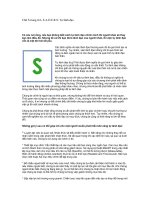Purple Cow
Bạn đang xem bản rút gọn của tài liệu. Xem và tải ngay bản đầy đủ của tài liệu tại đây (1.83 MB, 160 trang )
Purple Cow
Transform
Your Business
By Being
Remarkable
Seth Godin
epenguin
frontmatter 28/10/03 12:10 pm Page 1
visit Penguin at:
www.penguin.com
about the author
Seth Godin is the author of four
worldwide bestsellers including
Permission Marketing, Unleashing the Ideavirus and Survival is Not
Enough. He is a renowned public speaker and is contributing editor at
Fast Company magazine.You can find him at www.sethgodin.com
frontmatter 28/10/03 12:10 pm Page 2
This is a work of fiction. Names, characters, places, and incidents are either the product of the author’s
imagination or are used fictitiously, and any resemblance to actual persons, living or dead, business
establishments, events or locales is entirely coincidental.
Portfolio Book / published by arrangement with the author
All rights reserved.
Copyright © 2002 by Do You Zoom, Inc.
This book may not be reproduced in whole or part, by
mimeograph or any other means, without permission.
Making or distributing electronic copies of this book constitutes copyright infringement and could
subject the infringer to criminal and civil liability.
For information address:
The Berkley Publishing Group, a division of Penguin Putnam Inc.,
375 Hudson Street, New York, New York 10014.
The Penguin Putnam Inc. World Wide Web site address is
ISBN: 0-7865-4431-7
Portfolio Books first published by Penguin Publishing Group,
a member of Penguin Putnam Inc.,
375 Hudson Street, New York, New York 10014.
Electronic edition: February 2004
Purple Cow
Portfolio and the "Portfolio" design are trademarks belonging to Penguin Putnam Inc.
PORTFOLIO BOOK®
In Memory of Lionel Poilane,
Remarkable in Every Way.
Purple Cow-1st Print_crx.qrk 7/15/03 10:10 AM Page v
Purple Cow-1st Print_crx.qrk 7/15/03 10:10 AM Page vi
Contents
NOT ENOUGH Ps1
THE NEW P 2
BOLDFACED WORDS AND GUTSY ASSERTIONS 3
BEFORE, DURING, AND AFTER 4
THE GREATEST THING SINCE SLICED BREAD 5
DID YOU NOTICE THE REVOLUTION? 5
WHY YOU NEED THE PURPLE COW 8
THE DEATH OF THE
TV-INDUSTRIAL COMPLEX 13
BEFORE AND AFTER 17
CONSIDER THE BEETLE 18
WHAT WORKS? 20
WHY THE WALL STREET JOURNAL ANNOYS
ME SO MUCH 21
AWARENESS IS NOT THE POINT 23
THE WILL AND THE WAY 24
CASE STUDY: GOING UP? 25
CASE STUDY: WHAT SHOULD TIDE DO? 27
GETTING IN 28
IDEAS THAT SPREAD, WIN 31
THE BIG MISUNDERSTANDING 33
WHO’S LISTENING? 35
vii
Purple Cow-1st Print_crx.qrk 7/15/03 10:10 AM Page vii
CHEATING 38
WHO CARES? 39
NOT ALL CUSTOMERS ARE THE SAME 41
THE LAW OF LARGE NUMBERS 42
CASE STUDY: CHIP CONLEY 44
THE PROBLEM WITH THE COW 45
FOLLOW THE LEADER 51
CASE STUDY: THE AERON CHAIR 53
PROJECTIONS, PROFITS, AND THE PURPLE COW 55
CASE STUDY: THE BEST BAKER IN THE WORLD 58
MASS MARKETERS HATE TO MEASURE 59
CASE STUDY: LOGITECH 60
WHO WINS IN THE WORLD OF THE COW 61
CASE STUDY: A NEW KIND OF KIWI 62
THE BENEFITS OF BEING THE COW 63
CASE STUDY: THE ITALIAN BUTCHER 65
WALL STREET AND THE COW 66
THE OPPOSITE OF “REMARKABLE” 67
THE PEARL IN THE BOTTLE 68
THE PARODY PARADOX 70
SEVENTY-TWO PEARL JAM ALBUMS 72
CASE STUDY: CURAD 74
SIT THERE, DON’T JUST DO SOMETHING 75
CASE STUDY: UNITED STATES POSTAL SERVICE 77
Contents
viii
Purple Cow-1st Print_crx.qrk 7/15/03 10:10 AM Page viii
IN SEARCH OF OTAKU 79
CASE STUDY: HOW DUTCH BOY
STIRRED UP THE PAINT BUSINESS 81
CASE STUDY: KRISPY KREME 83
THE PROCESS AND THE PLAN 85
THE POWER OF A SLOGAN 87
CASE STUDY: THE HÄAGEN-DAZS
IN BRONXVILLE 89
SELL WHAT PEOPLE ARE BUYING
(AND TALKING ABOUT!) 90
THE PROBLEM WITH COMPROMISE 92
CASE STUDY: MOTOROLA AND NOKIA 93
THE MAGIC CYCLE OF THE COW 94
WHAT IT MEANS TO BE A MARKETER TODAY 96
MARKETERS NO LONGER:
NOW WE’RE DESIGNERS 98
WHAT DOES HOWARD KNOW? 99
DO YOU HAVE TO BE OUTRAGEOUS
TO BE REMARKABLE? 102
CASE STUDY: MCDONALD’S FRANCE 103
BUT WHAT ABOUT THE FACTORY? 104
THE PROBLEM WITH CHEAP 106
CASE STUDY: WHAT SHOULD
HALLMARK.COM DO? 108
Contents
ix
Purple Cow-1st Print_crx.qrk 7/15/03 10:10 AM Page ix
WHEN THE COW LOOKS FOR A JOB 110
CASE STUDY: TRACEY THE PUBLICIST 112
CASE STUDY: ROBYN WATERS GETS IT 113
CASE STUDY: SO POPULAR, NO ONE
GOES THERE ANYMORE 114
IS IT ABOUT PASSION? 117
TRUE FACTS 119
BRAINSTORMS 122
SALT IS NOT BORING—EIGHT MORE WAYS
TO BRING THE COW TO WORK 136
BRAND AND COMPANY INDEX 138
WHAT WOULD ORWELL SAY? 142
ABOUT THE AUTHOR 143
MORE INFORMATION 144
DRINK A PURPLE COW—FOR FREE! 145
Contents
x
Purple Cow-1st Print_crx.qrk 7/15/03 10:10 AM Page x
“Tastes like chicken”
isn’t a compliment.
“Nobody laughs at
old jokes any more.”
Max Godin
You are a post-consumption consumer.
You have everything you need,
and most everything you want.
Except time.
“Marketing is too important to be left to the
marketing department.”
David Packard
“Everything that can be invented has been invented.”
Charles H. Duell, 1899,
U.S. Commissioner of Patents
Purple Cow-1st Print_crx.qrk 7/15/03 10:10 AM Page xi
Purple Cow-1st Print_crx.qrk 7/15/03 10:10 AM Page xii
Purple Cow-1st Print_crx.qrk 7/15/03 10:10 AM Page xiii
Purple Cow-1st Print_crx.qrk 7/15/03 10:10 AM Page xiv
Not Enough Ps
Marketers for years have talked about the five Ps of mar-
keting. (There are more than five of them, but everyone
has their favorite five.) Some of them include:
• Product
• Pricing
• Promotion
• Positioning
• Publicity
• Packaging
• Pass-along
• Permission
This is the marketing checklist: a quick way to make sure
you’ve done your job, a way to describe how you’re going
to go about getting people to buy what the factory just
made. If the elements are out of whack with each other
(for example, puréed meals that you market to senior cit-
izens but taste like baby food), then the marketing message
is blurred and ultimately ineffective.
1
Purple Cow-1st Print_crx.qrk 7/15/03 10:10 AM Page 1
Marketing isn’t guaranteed to work, but the way things
used to be, if you got all your Ps right, you were more like-
ly than not to succeed.
Something disturbing has happened, though. The Ps
just aren’t enough. This is a book about a new P, a P that is
suddenly exceptionally important.
The New P
The new P is “Purple Cow.”
When my family and I were driving through France a few
years ago, we were enchanted by the hundreds of storybook
cows grazing on picturesque pastures right next to the
highway. For dozens of kilometers, we all gazed out the
window, marveling about how beautiful everything was.
Then, within twenty minutes, we started ignoring the
cows. The new cows were just like the old cows, and what
once was amazing was now common. Worse than common.
It was boring.
Cows, after you’ve seen them for a while, are boring.
They may be perfect cows, attractive cows, cows with great
personalities, cows lit by beautiful light, but they’re still
boring.
A Purple Cow, though. Now that would be interesting.
(For a while.)
The essence of the Purple Cow is that it must be
remarkable. In fact, if “remarkable” started with a P, I
could probably dispense with the cow subterfuge, but what
can you do?
This book is about the why, the what, and the how of
remarkable.
Seth Godin
2
Purple Cow-1st Print_crx.qrk 7/15/03 10:10 AM Page 2
Boldfaced Words and Gutsy Assertions
Something remarkable is worth talking about. Worth
noticing. Exceptional. New. Interesting. It’s a Purple
Cow. Boring stuff is invisible. It’s a brown cow.
Remarkable marketing is the art of building things
worth noticing right into your product or service. Not
slapping on marketing as a last-minute add-on, but
understanding that if your offering itself isn’t remarkable,
it’s invisible.
The TV-industrial complex was the symbiotic relation-
ship between consumer demand, TV advertising, and
ever-growing companies that were built around invest-
ments in ever-increasing marketing expenditures.
The post-consumption consumer is out of things to
buy. We have what we need, we want very little, and we’re
too busy to spend a lot of time researching something
you’ve worked hard to create for us.
The marketing department takes a nearly finished
product or service and spends money to communicate its
special benefits to a target audience. This approach no
longer works.
I believe we’ve now reached the point where we can no
longer market directly to the masses. We’ve created a world
where most products are invisible. Over the past two
decades, smart business writers have pointed out that the
dynamic of marketing is changing. Marketers have read
and talked about those ideas, and even used some of them,
but have maintained the essence of their old marketing
strategies. The traditional approaches are now obsolete,
though. One hundred years of marketing thought are
gone. Alternative approaches aren’t a novelty–they are all
we’ve got left.
Purple Cow
3
Purple Cow-1st Print_crx.qrk 7/15/03 10:10 AM Page 3
This is a book about why you need to put a Purple Cow
into everything you build, why TV and mass media are no
longer your secret weapons, and why the profession of
marketing has been changed forever.
Stop advertising and start innovating.
Before, During, and After
Before Advertising, there was word of mouth. Products and
services that could solve a problem got talked about and
eventually got purchased.
The best vegetable seller at the market had a reputation,
and her booth was always crowded.
During Advertising, the combination of increasing prosper-
ity, seemingly endless consumer desire, and the power of
television and mass media led to a magic formula: If you
advertised directly to the consumer (every consumer),
sales would go up.
A partnership with the right ad agency and the right
banker meant you could drive a company to be almost as
big as you could imagine.
After Advertising, we’re almost back where we started. But
instead of products succeeding by slow and awkward word
of mouth, the power of our new networks allows remark-
able ideas to diffuse through segments of the population at
rocket speed.
As marketers, we know the old stuff isn’t working. And
we know why: because as consumers, we’re too busy to pay
attention to advertising, but we’re desperate to find good
stuff that solves our problems.
Seth Godin
4
Purple Cow-1st Print_crx.qrk 7/15/03 10:10 AM Page 4
The Greatest Thing Since Sliced Bread
In 1912, Otto Frederick Rohwedder invented sliced bread.
What a great idea: a simple machine that could take a loaf
of bread and slice it. The machine was a complete fail-
ure. This was the beginning of the advertising age, and
that meant that a good product with lousy marketing had
very little chance of success.
It wasn’t until about twenty years later – when a new brand
called Wonder started marketing sliced bread – that the
invention caught on. It was the packaging and the adver-
tising (“builds strong bodies twelve ways”) that worked,
not the sheer convenience and innovation of pre-slicing
bread.
Did You Notice the Revolution?
Over the past twenty years, a quiet revolution has changed
the way some people think about marketing.
Tom Peters took the first whack with The Pursuit of Wow, a
visionary book that described why the only products with a
future were those created by passionate people. Too often,
big companies are scared companies, and they work to
minimize any variation–including the good stuff that
happens when people who care create something special.
Peppers and Rogers, in The One to One Future, took a sim-
ple truth–that it’s cheaper to keep an old customer than it
is to get a new one–and articulated the entire field of cus-
tomer relationship management. They showed that there
are only four kinds of people (prospects, customers, loyal
customers, and former customers) and that loyal cus-
tomers are often happy to spend more money with you.
Purple Cow
5
Purple Cow-1st Print_crx.qrk 7/15/03 10:10 AM Page 5
In Crossing the Chasm, Geoff Moore outlined how new
products and new ideas move through a population. They
follow a curve, beginning with innovators and early
adopters, growing into the majority, and eventually reach-
ing the laggards. While Moore focused on technology
products, his insights about the curve apply to just about
every product or service offered to any audience.
Moore’s idea diffusion curve shows how a successful business inno-
vation moves – from left to right – and affects ever more consumers until it
finally reaches everyone. The x-axis, along the bottom, shows the different
groups an idea encounters over time, while the y-axis shows how many peo-
ple are in each group.
In The Tipping Point, Malcolm Gladwell clearly articulated
how ideas spread through populations, from one person
to another. In Unleashing the Ideavirus, I pushed this idea even
further, describing how the most effective business ideas
are the ones that spread.
And finally, in Permission Marketing, I outlined the ever-
growing attention deficit that marketers face. I also dis-
cussed how companies win when they treat the attention of
Seth Godin
6
Purple Cow-1st Print_crx.qrk 7/15/03 10:10 AM Page 6
their prospects as an asset, not as a resource to be strip-
mined and then abandoned.
At many companies, most of these proven ideas have
been treated as novelties. My friend Nancy is the head of
“new media” at one of the largest packaged-goods compa-
nies in the world. Guess what? She’s in charge (she’s a
department of one) of all of these new ideas. “New media”
has become a synonym for “no budget.”
Instead of accepting that the old ways are fading away
(fast), most companies with a product to market are treat-
ing these proven new techniques as interesting fads – worth
another look but not worth using as the center of their
strategy.
The squeeze play. Marketers can’t get the word out because jaded consumers
refuse to share their attention. Customers rely on their tried-and-true sup-
pliers or on their network of smart friends instead of studying the ads on TV.
Purple Cow
7
Purple Cow-1st Print_crx.qrk 7/15/03 10:10 AM Page 7
Why You Need the Purple Cow
Forty years ago, Ron Simek, owner of the Tombstone Tap (a
bar named for the cemetery next door), decided to offer a
frozen version of his pizza to his customers. It caught on,
and before long, Tombstone Pizza was dominating your
grocer’s freezer. Kraft Foods bought the brand in 1986,
advertised it like crazy, and made billions. This was a great
American success story – invent a product everyone wants,
advertise it to the masses, and make a lot of money.
This strategy didn’t just work for pizza. It worked for
almost everything in your house, including aspirin.
Imagine how much fun it must have been to be the first
person to market aspirin. Here was a product that just
about every person on earth needed and wanted. A prod-
uct that was inexpensive, easy to try, and immediately
beneficial.
Obviously, it was a big hit.
Today, a quick visit to the drugstore turns up: Advil,
Aleve, Alka-Seltzer Morning Relief, Anacin, Ascriptin,
Aspergum, Bayer, Bayer Children’s, Bayer Regimen,
Bayer Women’s, BC, Bufferin, Cope, Ecotrin, Excedrin
Extra Strength, Goody’s, Motrin, Nuprin, St. Joseph,
Tylenol, and of course, Vanquish. Within each of these
brands, there are variations, sizes, and generics, adding
up to more than a hundred products to choose from.
Think it’s still easy to be an aspirin marketer?
If you developed a new kind of pain reliever, even one
that was a bit better than all of those I just listed, what
would you do?
The obvious answer, if you’ve got money and you believe
in your product, is to spend all you’ve got to buy tons of
national TV and print advertising.
Seth Godin
8
Purple Cow-1st Print_crx.qrk 7/15/03 10:10 AM Page 8
You’ll face a few problems, though. First you need
people who want to buy a pain reliever. While it’s a huge
market, it’s not everyone.
Once you find people who buy pain relievers, then you
need people who want to buy a new kind. After all, plenty
of people want the “original” kind, the kind they grew up
with. If someone has found a convenient, trusted, effec-
tive pain reliever, he’s probably not out there wasting time
looking for a replacement.
Finally, you need to find the people willing to listen to
you talk about your new pain reliever. The vast majority of
folks are just too busy and will ignore you, regardless of
how many ads you buy.
So . . . you just went from an audience of everyone to an
audience of a fraction the size. Not only are these folks
hard to find, but they’re picky as well.
Being first in the frozen pizza category was a good idea.
Being first in pain relievers was an even better idea. Alas,
they’re both taken.
Let’s consider yoga books for a second. The problem
with books about how to do yoga is that there are too many
of them.
A few years ago, when yoga books were scarce, all a pub-
lisher needed to be successful was a good yoga book. If
people had a yoga problem, they’d visit the local book-
store, take a quick look at the three or four books avail-
able, and buy one.
Today, though, there are more than five hundred books
on yoga. Nobody, no matter how motivated, takes the time
to review all five hundred before buying a book on yoga.
So if you’ve just written one, you’ve got a challenge ahead
of you. Not only is there a huge amount of competition,
but new books on yoga are useless to people who have
Purple Cow
9
Purple Cow-1st Print_crx.qrk 7/15/03 10:10 AM Page 9
already solved their yoga problem. All those folks who vis-
ited the store a few years ago and made yoga books so pop-
ular are no longer shopping for yoga books!
Here’s the sad truth about marketing just about any-
thing, whether it’s a product or a service, whether it’s mar-
keted to consumers or to corporations:
Most people can’t buy your product. Either they
don’t have the money, they don’t have the time, or
they don’t want it.
If an audience doesn’t have the money to buy what
you’re selling at the price you need to sell it for, you
don’t have a market.
If an audience doesn’t have the time to listen to and
understand your pitch, you’ll be treated as if you
were invisible.
And if an audience takes the time to hear your pitch
but decides they don’t want it . . . well, you’re not
going to get very far.
The world has changed. There are far more choices, but there is less and less
time to sort them out.
Seth Godin
10
Purple Cow-1st Print_crx.qrk 7/15/03 10:10 AM Page 10
This wasn’t true just twenty years ago. Way back then,
consumers had a lot more time and far fewer choices. Our
disposable income had fewer ways to get squandered, so if
a company came up with a really neat innovation (the cell
phone, for example), we’d find a way to pay for it.
Years ago, our highly productive economy figured out
how to satisfy almost everyone’s needs. Then the game
changed – it was all about satisfying our wants. The market-
ing community taught us (with plenty of TV advertising)
to want more and more, and consumers did their best to
keep up.
Among the people who might buy your product, most will
never hear about it. There are so many alternatives now
that people can no longer be easily reached by mass media.
Busy consumers ignore unwanted messages, while your
competition (which already has market share to defend) is
willing to overspend to maintain that market share.
Worse still, people are getting harder to reach by per-
mission media. Just because you have someone’s email
address or phone number doesn’t mean they want to hear
from you! And setting aside the spam issues, even when
people do want to hear from you by phone or mail or
email, they are less and less likely to take action. Your sat-
isfied consumers value these messages less because those
messages no longer solve their current problems.
Companies have gotten better at understanding what sat-
isfies their consumers (and presumably have gotten better
at delivering it), so the bar keeps getting raised as to what
product news you can possibly deliver that will add to that
satisfaction. I wasn’t being totally facetious when I quoted
the former head of the U.S. Patent and Trademark Office.
Almost everything we can realistically imagine that we need
has been invented.
The last hurdle is that ideavirus networks are hard to
Purple Cow
11
Purple Cow-1st Print_crx.qrk 7/15/03 10:10 AM Page 11









